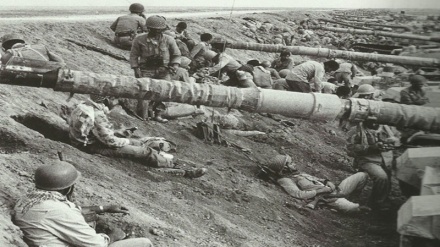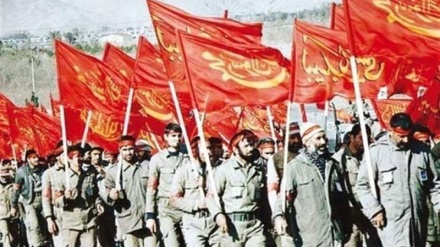Glimpses of Epic of 8-Years Holy Defense (71)
In the previous program we talked about the widespread use of Saddam’s Ba’thist regime of chemical weapons for retaking Faw region from the Iranian combatants.
We also said with the vast resistance of Iranian combatants, the Ba’thist enemy was disappointed from continuing counterattack to retake the lost lands, and the area of Rais al-Bisheh to Faw and to the salt lake continued to be under control of Iranian combatants.
As a result of the presence of Iranian forces along the coast of Khor Abdullah, the sea link of the Iraqi regime with the Persian Gulf was cut off.
It took more than seventy days to repel enemy counterattacks and stabilize the operation area. Since in this longest operation, the most breathtaking conflict took place during the Valfajr 8 operation which the Iraq commanders called "back breaking". As a result the will, and power of confrontation of the Ba’thist army broke. With the passage of a week of the presence of Iranian forces in the Faw region, Iraq was disappointed of having any success. The battleground around Faw is such that it does not allow the use of a large number of forces in the area.
Defense Minister Adnan Khairullah also said it was difficult to recapture the Faw Peninsula from the Iranians. The existence of swamps and salt mines in this land was a major obstacle for the Iraqi units. Maher Abdur Rashid, commander of the 7th Iraqi division, also said that Iran has used new military tactics in its current operations. Contrary to the expectation of the difficult weather with heavy rains, frogmen and martial combatants began their attack on Iraqi positions.
One of Val-Fajr's most important operational phases was transfer of thousands of Iranian combatants across Arvand River. After the capture of the Faw area, support was first required for light vessels and light tugboats. Hundreds of boats also carried the task of transferring forces and light facilities. However, the provision of thousands of combatants who crossed Arvand River required the construction of a fixed bridge on the waterway. Accordingly, before the start of the operation, it was anticipated that near the mouth of Arvand River, a bridge should be constructed from which a variety of heavy equipment, such as tanks, armoured carriers and engineering machinery could be transported. The mission of this great work was the responsibility of Construction Jihad Organization.
The engineering and support forces of construction Jihad constructed a bridge with a length of about 600 meters and a width of about 12 meters and about 8 meters in height, using approximately 3,400 pipelines of 56 inches and with a precise engineering design. The designer and supervisor of the bridge, Engineer Behrouz Pou-Sharifi was responsible for engineering support for the construction Jihad War, who later in 1996 died in a car accident. The construction of this bridge was faced with numerous problems, such as the tidal waters of the Arvand River, winds and storms, as well as artillery fire and enemy air bombardment, which caused temporary cessation in its construction.
Eventually, after about 6 months of steady and overnight work, the final stage of the pavilion preparation and pavement completed on October 7, 1986 and traffic began. The 56-inch, 80-kilometer long pipelines that were taken from Iraq as war booty were used to build the bridge. This bridge connected the Faw area with Iran and was considered a great success in warfare engineering..
The most important goal of Val-Fajr 8 was to achieve a decisive military victory on the battlefields. The Father of the Islamic Revolution, Imam Khomeini, insisted that the aggressor of the war should be identified and condemned. The Val-Fajr 8 operations was thus in granting further success to the Iranian and shatter the power of the Iraqi aggressors. Operation Val-Fajr 8 boosted Iran's hope for a military solution to end the war. The role of artillery was very important for both sides, and in the days of the conflict, the exchange of artillery fire was very intense. Passing through Arvand River made global powers sure that Iran could achieve a decisive victory in the war.
Faw operation was the biggest victory of the Islamic combatants after the liberation of Khorramshahr in 1982. The great success of the operation, after about three years since Bayt al-Moqaddas Operation, was the beginning of a major development on the battlefields, which in turn led to other successes, including Karbala 1 operation, the liberation of Mehran and Val-Fajr 10 operation.
The unexpected operation of Iran in the very important Faw area has surprised Saddam regime's supporters. Prior to this operation, the US, the Soviet Union and the Arab states supporting Saddam thought that the Baathist regime in Iraq could prevent the advance of the Iranian forces and, therefore, did not assess the continuation of the war detrimental to them. . But Val-Fajr 8 operation eroded their views and calculations so that the great development of Baathist military power was on the agenda of the great world powers and the Arab states, and started new measures to prevent the Baathist military defeat in the imposed war.
The operation was carried out on the basis of a sophisticated and initiative military thinking by trained, brave and martyrdom-seeking humans who were able to surprise the enemy with appropriate tactics, and therefore assessed the military capability of the IRGC both inside and outside the country. We will talk more about this in the next program.
FK/AS/SS


